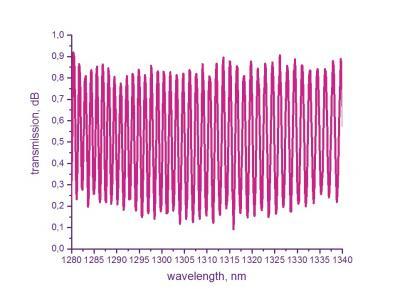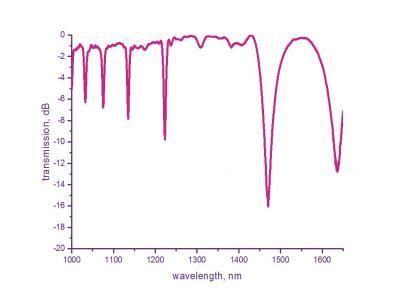ARTICLE GTL-LPFG-810


Long Period Fiber Grating is so named because period index change is on the order of 100 microns rather than the 0.5 microns for FBG. An LPFG couples light that is propagating along the fiber core of a Single Mode fiber into cladding modes. LPFGs operate in transmission. There is no reflected signal. There are several picks with different intensities in LPFGs optical spectrum which are corresponding various cladding modes interaction.
LPFGs are widely used as optical filters. It is essential for systems sensitive to reflection. LPFG written in a birefringent fiber may also be used as a polarization-depended absorbing spectral filter. The LPFGs are very sensitive to temperature changes, strain and refractive index of the surrounding medium. Their thermal sensitivity depends on fiber type and order of cladding mode interaction. Additionally, pair of 50% LPFGs can be used to form in fiber Mach-Zehnder interferometer. The Mach-Zehnder interferometer transmission spectrum is presented in the graph.
FBG CHARACTERISTICS | ARTICLE GTL-LPFG-810 | TOLERANCE/NOTE |
| Wavelength range, nm | 1000 ÷ 1700 | ± 0.2 ÷ ± 1 custom request |
| Types of fiber | Single-Mode, PM | or custom |
| LPG Length, mm | ‹ 50 | custom request |
| Period, um | 200 ÷ 500 | or custom |
| Peak Intensity, dB / % | 10 ÷ 99 | ±5 |
| Bandwidth (WFHM), nm | ≥ 10 | ±2 |
| Loss free spectral range | custom request |
|
| FBG Pigtail Length, m | ≥ 0.5 | or custom |
| FBG Recoating | None, Acrylate, Polyimide, Aluminium, Copper | or custom |
| Tensile Strength, kpsi | › 100 |
|
| Optical Connector | Bare fiber, FC/APC, LC/APC | or custom |
